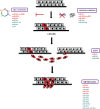Micrornas in prostate cancer: an overview
- PMID: 28445135
- PMCID: PMC5564846
- DOI: 10.18632/oncotarget.16933
Micrornas in prostate cancer: an overview
Abstract
Prostate cancer is the second highest cause of cancer mortality after lung tumours. In USA it affects about 2.8 million men and the incidence increases with age in many countries. Therefore, early diagnosis is a very important step for patient clinical evaluation and for a selective and efficient therapy. The study of miRNAs' functions and molecular mechanisms has brought new knowledge in biological processes of cancer. In prostate cancer there is a deregulation of several miRNAs that may function as tumour suppressors or oncogenes. The aim of this review is to analyze the progress made to our understanding of the role of miRNA dysregulation in prostate cancer tumourigenesis.
Keywords: biomarkers; microRNAs; oncogenic miRNAs; prostate cancer; tumor suppressor miRNAs.
Conflict of interest statement
The authors declare no conflicts of interest.
Figures

References
-
- Gronberg H. Prostate cancer epidemiology. Lancet. 2003;361:859–64. - PubMed
-
- Caraglia M, Alaia C, Grimaldi A, Boccellino M, Quagliuolo L. MiRNA as prognostic and therapeutic targets in tumor of male urogenital tract. Mol Targets Strat Cancer Prev. 2016;7:151–171.
-
- Fong MK, Hare R, Jarkowski A. A new era for castrate resistant prostate cancer: a treatment review and update. J Oncol Pharm Pract. 2012;18:343–354. - PubMed
-
- Rodrigues DN, Butler LM, Estelles DL, de Bono JS. Molecular pathology and prostate cancer therapeutics: from biology to bedside. J Pathol. 2013;232:178–184. - PubMed
-
- Facchini G, Caraglia M, Morabito A, Marra M, Piccirillo MC, Bochicchio AM, Striano S, Marra L, Nasti G, Ferrari E, Leopardo D, Vitale G, Gentilini D, et al. Metronomic administration of zoledronic acid and taxotere combination in castration resistant prostate cancer patients, Phase I ZANTE Trial. Cancer Biol Ther. 2010;10:543–8. - PubMed
Publication types
MeSH terms
Substances
LinkOut - more resources
Full Text Sources
Other Literature Sources
Medical

